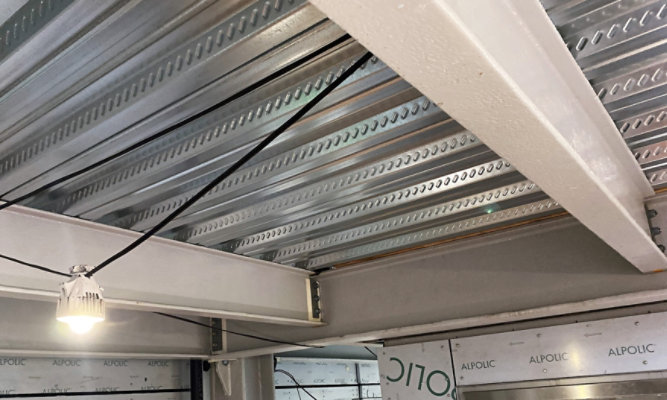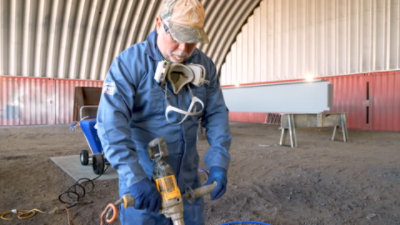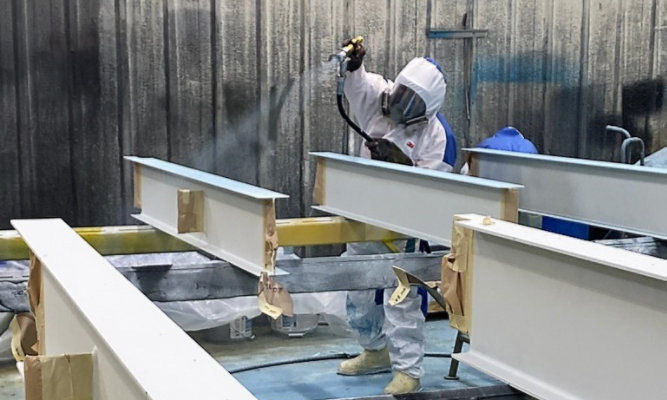Reducing the Carbon Footprint with Intumescent Fireproofing
How Thoughtful Building Design Practices for Fire Protection with Intumescent Coatings Can Support Greener Builds and Reduce Carbon Emissions
by George Guanci, Market Manager – Fire Protection, Sherwin-Williams Protective & Marine
Andrea Dinice, Architectural Account Executive, Sherwin-Williams
Contact Us for More Information

Reducing Carbon Emissions in the Construction Sector with Intumescent Fireproofing
Intumescent fireproofing products have a range of applications in many types of buildings and structures – offering not only passive fire protection but also enhancing aesthetic appeal. Surprisingly, they can also play a significant role in reducing carbon emissions and improving environmental sustainability within the construction sector.
In looking at the relationship between intumescent fireproofing products and a carbon footprint reduction, it’s necessary to understand the following topics:
- What intumescent fireproofing is
- How intumescent fireproofing contributes to sustainable building design
- How to generate carbon dioxide (CO2) data from Environmental Product Declarations (EPDs) so you can compare products
- How to calculate the carbon equivalent value of a building’s fireproofing design
This article reviews each of the above topics to help you better understand the sustainability implications offered by using specific intumescent fireproofing products to protect buildings during fires.
The Role of Intumescent Fireproofing: Securing Safety and Reducing the Carbon Footprint
The primary purpose of intumescent fireproofing is to protect human life. At the very least, it needs to afford occupants the opportunity to evacuate safely. Beyond serving as this pivotal life-safety measure within buildings, fireproofing also plays a crucial role in preserving the structural integrity of the structure. Given the potential for intense and prolonged fires to induce structural collapse, fireproofing stands as a vital line of defense.
When steel remains unprotected and is exposed to temperatures nearing 1,000 degrees Fahrenheit (F), it undergoes a reduction of approximately 50% in its load-bearing capacity.
Another way to explain this is that once fireproofing reaches approximately 1,000°F, it loses about 50% of its structural integrity – and when the temperature goes higher, the process of degradation accelerates rapidly. Fireproofing is meant to inhibit steel from surpassing this critical temperature threshold. For instance, a fireproofing system with a one-hour rating effectively safeguards steel structures, ensuring the steel remains below 1,000°F, for the duration of one hour.
Intumescent coatings are formulated with active ingredients, known as pigments, which initiate a reaction when the steel core temperature reaches approximately 300°F. This reaction prompts the intumescent fireproofing to expand and generate a char, which provides fire-retardant properties to the steel. The insulating char blocks heat from the fire, slowing down the rate at which the steel temperature rises.
Thus, this decelerated temperature increase prolongs the duration it takes for the steel to reach the critical threshold where it loses its ability to sustain the imposed load, ultimately leading to structural collapse. The amount of time it takes for steel to reach the 1,000°F threshold is determined by the type of intumescent coating used, as well as the thickness at which the material is applied.
Creating Green Buildings and Reducing Carbon Emissions with Intumescent Fireproofing
In many building construction projects, the ultimate goal is to create a “green building.” Green buildings are those meticulously planned, built and managed with the aim of bolstering the well-being of their inhabitants, while fostering a healthy community and preserving the natural environment.
The adoption of related green building certification programs continues to increase and now represents a significant portion of construction projects. While there are some differences between the programs, all provide a set of tools and rating systems to assess a project’s performance from a sustainability, life cycle and environmental perspective. Upon project completion, a building undergoes assessment and is awarded a rating and certification, affirming its performance in accordance with the chosen program.
The Leadership in Energy and Environmental Design program, or LEED, is administered by the U.S. Green Building Council. Since its creation in 1998, the program has become one of the most recognized global standards. It operates on an externally verified, 100-point system with four tiers of certification, in progressive order of stringency: Certified, Silver, Gold or Platinum.
Intumescent fireproofing products can contribute toward the achievement of LEED credits and certification.
By LEED standards, at least 75% of all paints and coatings used on a project, by volume or surface area, must meet the volatile organic compounds (VOC) emissions criterion to contribute to LEED credits. This encompasses paints and coatings that are applied directly at the construction site, including those used for interior surfaces of buildings. Coatings applied offsite – and those used in “non-interior” spaces – are not typically part of a project’s consideration for LEED credits or certification. Therefore, building owners have two ways to help with securing LEED credits when using intumescent coatings – 1) using coatings that meet VOC restrictions, whether applied onsite or offsite; and/or 2) applying nearly all intumescent coatings offsite, with the exception of all steel connection points, which will need to be coated onsite after assembly.
Sometimes, coatings are also required to meet air quality standards, including California Department of Public Health (CDPH) standards, for VOC content and emissions.
Life Cycle Assessment (LCA) is a technique used to assess environmental impacts associated with all stages of a product’s life cycle. It’s used a basis in determining LEED credits and relies on data disclosed in a product’s EPD, or Environmental Product Declaration. Such EPDs estimate how a product affects the environment and are essentially a stamp of approval indicating that a product’s environmental impact has been accurately calculated by an independent authority. EPDs are recognized by many green building certification programs as a reliable way to measure a product’s environmental performance.

The “Cradle-to-Gate” approach to LEED covers the potential environmental impact from raw material extraction to production of the finished product. “Cradle-to-Grave” expands the investigation to cover extraction through to end-of-life management, as detailed on the diagram. The key point is that not all assessments are equal, and careful attention needs to be paid to the scope of the LCA and subsequent EPD.
The Cradle-to-Gate approach, within the LEED program, considers the environmental impact of a product from the extraction of raw materials to the production of the final product. On the other hand, a Cradle-to-Grave approach widens the scope – including not only extraction but also the management of the product until its end-of-life, as illustrated in the diagram. It’s key to note that not all assessments are the same, so it’s crucial to carefully consider the scope of the LCA and the subsequent EPD.
The EPD data that Sherwin-Williams Protective & Marine uses to analyze products for their carbon calculations is gleaned from a Cradle-to-Grave assessment.
Product Category Rules (PCR) are another term that’s important to understand. PCRs establish the guidelines for assessing a product to generate an LCA and report findings via an EPD. In this case, it’s specifically for architectural coatings, which are commonly used for painting buildings. This choice was made because it’s the most appropriate category and takes into account the need to repaint or reapply the coating over the building’s lifespan, which is typically assumed to be around 60 years.
PCRs “allow for review and comparison of different environmental product attributes among products in a defined category,” according to the National Sanitation Foundation (NSF).
Within the equations used to develop PCRs, LCAs and EPDs, “output” is the quantity of product needed for a building’s life, including the initial application and any subsequent maintenance applications. Output is reported as the Global Warming Potential (GWP) in kilograms of carbon dioxide equivalent (kg CO2 e). Essentially, this measure helps assess the climate change impact of different gases relative to carbon dioxide. This data can be used to calculate the CO2 emissions for specific projects.
Carbon equivalence information can be used to understand the carbon footprint of a protective coating system.
Leveraging Software for Precise Fire Protection and Carbon Footprint Reduction with Intumescent Coatings
In building design, software programs can be especially helpful for comparing different designs and determining the impact those designs may have on the amount of intumescent fireproofing required. Remember that the intumescent coating quantity required for a building can fluctuate based on the thickness of steel (with less fireproofing material typically needed on thicker steel) and the required building fire rating (with less fireproofing material typically needed for shorter fire ratings). In addition, a building can be designed in different ways to use thicker or thinner steel. Robust software can help building designers easily make design adjustments for quick comparisons.
Sherwin-Williams Protective & Marine uses, the Fire Design Estimator tool, or FDE, a third-party verified design and estimation software that has wide functionality. One of its key capabilities is to calculate accurate quantities and thicknesses of a specific Sherwin-Williams FIRETEX® product for a steel member, or the full set of steel members on a project. These thicknesses are taken directly from the certification of the individual products, such as what is listed in UL 263.
Through consolidating data for each item individually, the software computes the precise quantity of materials needed, including intumescent coatings and topcoats if necessary. This calculation encompasses the thickness of fire protection per product, along with overall volumes and weights of coatings required for the project, commonly referred to as the take-off.
The FDE can factor in the carbon equivalence of both the intumescent coatings and topcoats when estimating product requirements. In addition to providing the thicknesses required per beam and the total volume of products required for the project, it can also estimate a specific carbon equivalent weight for the entire amount of protection needed for a product and the project as a whole.
This ability represents a positive development in quantifying the carbon content of a project. Quickly and efficiently, software can be used to optimize carbon equivalence based on optimized steel sizes in the structure.
The software not only compares and contrasts different products but also calculates their varying thickness requirements and analyzes their carbon content. This enables designers to make well-informed decisions regarding intumescent fireproofing during the design phase.
As a result, manufacturers of intumescent fireproofing can offer product and software solutions to support designers, engineers, and applicators in creating sustainable structures. They can also provide a range of products that can contribute to green building credits, as well as enhanced, long-term in-service durability.
A combination of early engagement and collaboration with the architectural and engineering teams, with use of FDE software, can truly optimize intumescent fire protection solutions for structural steel. While being used to optimize cost effectiveness, manufacturers of intumescent fireproofing can also help with enhancing understanding of a project’s carbon equivalence as well.
Elevating Aesthetics, Efficiency and Sustainability with Intumescent Fireproofing
The aesthetic appeal of buildings cannot be overlooked or underestimated. Buildings serve many roles – as dwellings, places of work and leisure. How they look and their outward effects can be linked to how they’re maintained.
Contemporary buildings can provide a platform to inspire their occupants. The design of these buildings, and the materials used to make them have the potential to drive that inspiration. As such, the materials and processes used to build these structures, and the protective materials used to preserve the buildings, are critical for long-term, effective service.
An effective way to meet this ongoing concern is to perform coating and fire protection installation activities off-site – which was also already established as a means of enhancing a building’s LEED credit potential.
On a live project, there are real, quantifiable benefits in terms of the production rates for the fireproofing of steel. Off-site applications allow the health and safety challenges of coating steel on-site to be transferred to purpose-built facilities, designed to safely apply the products in an enclosed and regulated environment.
In addition, applicators are operating in safer working conditions, with reduced time spent working at heights. There can also be a reduction in trade clashes that can be experienced on-site. Easier access to steelwork means easier application of intumescent fireproofing. Ultimately, this leads to improvements in time and cost on quality control.
A Thoughtful Approach to Building Design and Reducing Carbon Emissions with Intumescent Fireproofing
While it is vitally important to make informed decisions throughout a building project, this is especially true during the design phase. For each project, calculations should be made that quantify the per-product and overall carbon equivalent. New tools allow for easier and quicker understanding of the impact of design changes and product choices. Intumescent fireproofing products with third-party certified EPDs contribute towards LEED credits and other similar programs that share a common goal of making construction more sustainable and responsible.
Design Green Buildings and Reduce Your Carbon Footprint with Intumescent Coatings from Sherwin-Williams
At Sherwin-Williams, we are committed to protecting steel structures and providing life-saving protection from fires. Our line of proven intumescent fireproof coating systems has been designed to deliver superior fire protection that meets the highest industry standards.
To learn more about our intumescent fire protective coatings, contact a Sherwin-Williams representative today.
ABOUT THE AUTHORS
George Guanci, Fire Protection Market Segment Manager for Sherwin-Williams Protective & Marine, is responsible for developing opportunities for the FIRETEX® commercial fireproofing product line in North America. He has over 40 years’ experience in the construction industry, most of which by serving the fire protection industry. Guanci has extensive experience in petrochemical and commercial fireproofing, as well as UL listings and requirements, international fireproofing standards and fireproofing specification development. He is a member of the American Institute of Architects (AIA), NACE International and the National Fire Protection Association (NFPA). Contact: George.M.Guanci@sherwin.com
Andrea Dinice began her career in architecture and interior design in 1984 and has 40 years of experience in all aspects of the building and coating industry. She has been employed as a Specifications Consultant by Sherwin-Williams for 15 years. Dinice attained her Construction Document Technologist (CDT) Certification in 2015 and was also named Architectural Account Executive of the Year by Sherwin-Williams. In 2017, she attained her LEED Green Associate and NACE Level coatings inspector credentials and has also earned her WELL AP certification through the International Well Building Institute (IWBI) in 2021. She served as Metropolitan NY Construction Specifications Institute (MNY CSI) President from 2019 to 2022 and currently serves as Vice President for Northeast Region of CSI. In addition, Dinice sits on the IWBI Materials Advisory Committee, Mindful Materials Manufacturer’s Engagement Group, serves as MNY CSI Chapter Membership Chair and is part of Sherwin-Williams Sustainability Ambassador team. In 2023, she was honored with a Sustainability Partner of the Year Award. Dinice continues to support the commercial architectural and design communities in New York City for Sherwin-Williams. Contact: Andrea.Dinice@sherwin.com.
Discover More
Industry Expertise and Innovation
See how we help customers find customized solutions for their project and application challenges.


